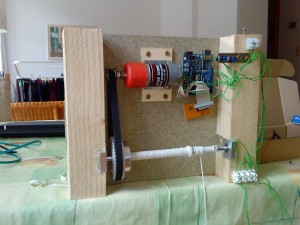Howto get Asterisk with mISDN V2 and Linux Call Router running on debian lenny
Update 2009-03-31: provide signed archive with archive key, add udev rules, add /etc/modules entries, add amd64.
Update 2009-04-05: typos fixed
This is a short howto how I built the debian patches and how you can — as a user — install everything needed for mISDN version 2 and Linux Call Router (LCR) with asterisk chan_lcr running on debian lenny.
I’m providing debian packages for Kernel (v 2.6.28.5), an updated zaptel (debian lenny zaptel doesn’t compile with newer kernels and zaptel wctdm uses some settings for analogue phones that don’t work with german and austrian phone like the “R”-key or optional pulse dialling), finally I’m providing a slightly patched asterisk for larger buffer sizes when playing long tones, LCR and misdnv2user packages originally built by Joerg Dorchain. My misdnv2user is the same as Joergs. The lcr package contains my bug-fix for DTMF digits A-F (also in Joergs packages now) which don’t work in upstream LCR version 1.3 and an updated /etc/init.d/lcr for querying the status of lcr.
I’m also providing source packages, except for the kernel — the kernel is stock kernel.org 2.6.28.5 configured for use of mISDN. The kernel was built using debians make-kpkg from the kernel-package debian package. And the config used for building the kernel is in the binary package.
I hope I can contribute something in order to get mISDN V2 and LCR into debian… in the meantime others may want to uses these on debian stable.
Installation
apt-get install vim less ssh ntp apt-get install python-dev openbsd-inetd postfix madplay
Add following lines to /etc/apt/sources.list:
deb http://project.runtux.com/asterisk/debian/ lenny main deb-src http://project.runtux.com/asterisk/debian/ lenny main
If you want to avoid warnings about an untrusted archive key from apt, you should import the following archive key. Save the key to a file and then issue the commandapt-key add file
—–BEGIN PGP PUBLIC KEY BLOCK—– Version: GnuPG v1.4.9 (GNU/Linux) mQENBEnREAIBCADM8+KpoC/HJUCEsx8KZhGgsX/G3ouR4/xkgIuIPgz+t6JoTisj 9QmymDZKUXSy04WmbLjU/088xD5A9ukOEYxoFCGqwWf1tPOKqN1oKpVCkjJb8Dht vvebqOCzJSV0nfqmIfkpbX+6dUssx+9u0BiFK3aj/GilkEloZl2g+vIT6fveJtKE qmxz19vL516TDhsbsv3/AKfNKc7QRpsgvPmnNE2IL0CTgQYs26WtnJASlu1MQpwo Qfb1PrO7ufq9eO58HjEBdfbSNjalQjVj7vLvE4GQglHULO500H9UlfOm2zpO0Vzs 5lGGbwLJdTpAS3HIRhQAW0pueRsQ8zagMn5lABEBAAG0OFJhbGYgU2NobGF0dGVy YmVjayAoRGViaWFuLVBhY2thZ2UtS2V5KSA8cnNjQHJ1bnR1eC5jb20+iQE2BBMB AgAgBQJJ0RACAhsDBgsJCAcDAgQVAggDBBYCAwECHgECF4AACgkQ5CizCR9G97ah pAf/eLRYtPVs1apI3+AVi//8y1/r6uL+IxI/Tlt53jCtX/dy3Q3FeAEJt/7fbvcW TBDnP5K8vWaYUlHHaz+6lbcQyV/KAH4LKJEKkyoINc9ytG1qEG6z8NPfDmKiEluy HksgLpAqUBrdZy46iWQhcg7f3fpcUIsHHcXrOd2Ip5G9DL2q4/UoRrhBhHC3GNX7 ERaeAKZTF1JRaVN6KSWPC2+yaNmuGn1yoSChG0Q/bBTgzv2fm9Jzvok546f9LE0q k2q5PvjlUSMGHHojTzzR6tGhnbw5mOfyMUDDs5LuAN1aWbDatepJgiC+dYasprQ5 pZygpoCASqIhWjjCZd3XI5mAEIhGBBARAgAGBQJJ0nZlAAoJEIO0FkDz/lcw0xYA njBSGef/4KhZpuspIh6WnLM7ORKNAKCw28et9bUoaGu4ESRpIwtwj4asQoicBBAB AgAGBQJJ0ncuAAoJEJWCQpSoBzk1hpcD/2KXiuvE2Nm0oOi0jBVEjT/Tu/GGkG5m lf97/I6TMcJxlMpeBlv9SiJD+/BBQo0MGMxmkCwU4t+eBCBsCVcr/bJnrlrKa4Ab 9SR9WQ8PGrSQ+AwMePCDKngqFd5EERz8bxz4sZKGCxn9JVRQOGp03eKSGDG/Yh0v FY3v7nV0BUaE =mPtt —–END PGP PUBLIC KEY BLOCK—–
Then install:
apt-get update
apt-get install linux-headers-2.6.28.5-i686 linux-image-2.6.28.5-i686
asterisk zaptel lcr zaptel-modules-2.6.28.5-i686
If you’re on the amd64 architecture, you should replace i686 in the packages above with amd64.
and optionally (for misdn_info):
apt-get install misdnv2user
Edit /etc/default/asterisk and set RUNASTERISK=yes. Then make several directories (should be done by a future version of the lcr package):
mkdir /var/run/lcr chown asterisk.asterisk /var/run/lcr mkdir /var/log/lcr chown asterisk.asterisk /var/log/lcr
I’ve also made a start-script for lcr (for use as /etc/init.d/lcr) ,
downloadable at http://project.runtux.com/asterisk/init.d:lcr
this probably should also be part of the lcr package.
Config file examples used for lcr — these pass
everything to asterisk. File /etc/lcr/interface.conf:
[Ext1] portnum 0 ptp nodtmf [Ext2] portnum 1 ptp nodtmf [Int1] portnum 2 nt ptp nodtmf [Int2] portnum 3 nt ptp nodtmf
I’m using a Beronet 4 port ISDN card, your config will probably differ: This system only expects incoming calls and needs to check on which line a call comes in. So I distinguish all external interfaces as separate interfaces of LCR. I also need to check an interface by calling out via that interface, you probably would want to make all external ports a trunk by grouping them into one LCR interface.
And the routing config needs to match your interface definition. This config will pass all calls — if asterisk is running — to asterisk. If asterisk isn’t running, I’m calling a test application (untested). The context in asterisk will be the interface name. Again, if you’re using a trunk here, be sure to match the routing config with your interface config. /etc/lcr/routing.conf:
[main] remote=asterisk interface=Ext1 : remote application=asterisk remote=asterisk interface=Ext2 : remote application=asterisk remote=asterisk interface=Int1 : remote application=asterisk remote=asterisk interface=Int2 : remote application=asterisk default : efi
Update /etc/modules to include the following lines (the command appends the lines between cat and EOF):
cat >> /etc/modules << EOF mISDN_core debug=0x0 mISDN_dsp debug=0x0 options=0x0 hfcmulti debug=0x0 EOF
Linux udev must be configured to correctly set the user for the isdn device(s):
cat > /etc/udev/rules.d/91-isdn.rules << EOF ACTION!=”add|change”, GOTO=”permissions_end” KERNEL==”mISDN*”, GROUP=”dialout” LABEL=”permissions_end” EOF
After a reboot asterisk and lcr should be running.
Building
Getting kernel:
wget http://kernel.org/pub/linux/kernel/v2.6/linux-2.6.28.tar.bz2 wget http://kernel.org/pub/linux/kernel/v2.6/linux-2.6.28.tar.bz2.sign wget http://kernel.org/pub/linux/kernel/v2.6/patch-2.6.28.5.gz wget http://kernel.org/pub/linux/kernel/v2.6/patch-2.6.28.5.gz.sign
For compilation (zlib isn’t checked by make-kpkg!):
apt-get install kernel-package bzip2 libncurses5-dev zaptel-source
zlib1g-dev fakeroot
Compile Kernel:
tar xvf linux-2.6.28.tar.bz2 cd linux-2.6.28 zcat ../patch-2.6.28.5.gz | patch -N -p1 | less 2>&1 cp /boot/config-2.6.28.5-i686 .config make oldconfig make menuconfig # just to be sure
For amd64:
make-kpkg –append-to-version -amd64 –revision 2.6.28.5.1.rsc –us
–uc –initrd –rootcmd fakeroot binary > m.out 2> m.err
For i686:
make-kpkg –append-to-version -i686 –revision 2.6.28.5.1.rsc –us
–uc –initrd –rootcmd fakeroot binary > m.out 2> m.err
The following doesn’t seem to work although zaptel is installed:
probably need to unpack /usr/src/zaptel.tar.bz2 into
/usr/src/modules/zaptel (tar file contains modules directory!)
this would save us from the m-a a-i step below. amd64:
make-kpkg –append-to-version -amd64 –revision 2.6.28.5.1.rsc –us
–uc –initrd –rootcmd fakeroot modules > mo.out 2> mo.err
cd ..
For i686:
make-kpkg –append-to-version -i686 –revision 2.6.28.5.1.rsc –us
–uc –initrd –rootcmd fakeroot modules > mo.out 2> mo.err
cd ..
Make a debianized zaptel for new kernel:
apt-get install devscripts libnewt-dev quilt libusb-dev asciidoc svn checkout http://svn.digium.com/svn/zaptel/branches/1.4 zaptel apt-get source zaptel-source cp zaptel/kernel/ztdummy.* zaptel-1.4.11~dfsg/kernel cd zaptel-1.4.11~dfsg # Add "Fix compilation for newer kernels" dch -i dpkg-buildpackage cd .. dpkg -i zaptel-source_1.4.11~dfsg-3.1_all.deb m-a a-i zaptel
The following installs my patched asterisk, I’m modifying some buffer sizes because I want to play long tones (I’m generating a faked modem guard-tone that is needed in a project). You probably won’t need the patches asterisk, but it won’t hurt to install it. The create-patches script is available from
http://project.runtux.com/asterisk/create-patches
apt-get install libreadline5-dev libgsm1-dev libssl-dev libtonezone-dev
libvpb-dev autotools-dev libsqlite-dev libspeex-dev libspeexdsp-dev
graphviz libcurl4-openssl-dev doxygen libpopt-dev libopenh323-dev
libiksemel-dev libradiusclient-ng-dev freetds-dev libvorbis-dev
libsnmp-dev libc-client2007b-dev libcap2-dev libpq-dev unixodbc-dev
libpri-dev
apt-get source asterisk
scp ralf@bee:checkout/own/config/asterisk/create-patches .
cd asterisk-1.4.21.2~dfsg/
sh ../create-patches
# Hunk #1 succeeded at 25 (offset 3 lines).
# Add "runtux.com local buffer-size patches"
# and new version-number 1:1.4.21.2.1~dfsg-3
dch -i # add comment
dpkg-buildpackage -rfakeroot
cd ..
For mISDNuser and chan_lcr I’m using Joerg Dorchains packages with my added patches for DTMF codes A-F.


